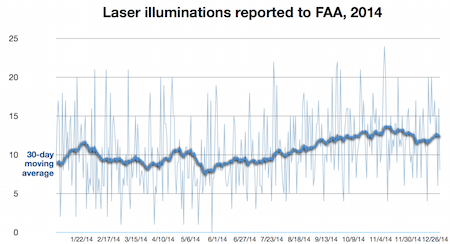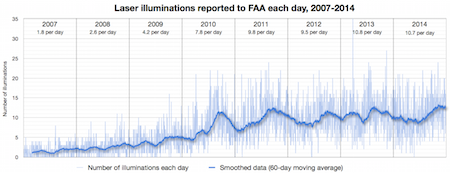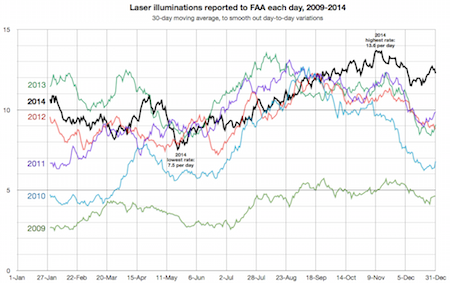Home
A comprehensive resource for safe and responsible laser use
US: UPDATED - FDA reminds consumers of laser pointer hazards
This is an update to a similar warning issued December 16 2010. It contains more specific guidance about how to tell whether a handheld pointer may be over the U.S. limit of 5 mW for a laser sold as a “pointer” or for pointing purposes.
Also, the 2015 version includes details about how to report potential laser injuries to FDA’s MedWatch medical device reporting system, and what information to include in the MedWatch report.
The full text of the FDA Safety Communication is below; click the “Read More…” link.
From U.S. FDA: December 22 2015 safety communication, and December 16 2010 safety notification
UPDATED February 19 2015 — The FDA also produced a video, entitled “Laser Pointer Safety”. The 3 1/2 minute presentation shows some of the hazards of laser pointers. It also gives recommendations on how to select and safely use laser pointers. From the FDA’s YouTube channel.Click to read more...
China: Military is equipped with blinding laser weapons
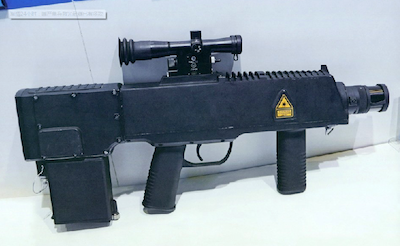
BBQ-905 Laser Dazzler Weapon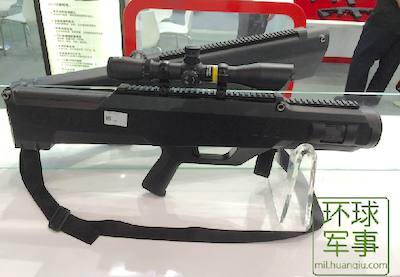
PY132A Blinding Laser Weapon
China’s use of the weapons appears to violate the 1998 Protocol on Blinding Laser Weapons, which China has agreed to follow. A Washington Free Beacon article quoted an expert on Chinese weapons as saying “There is a strong possibility these new dazzlers are being marketed for foreign sale.”
From China Military Online via the Washington Free Beacon. Additional photos showing the weapons and how they would be used are at Huanqui.com.
US: Study of U.S. incidents, 2010-2014 gives insights into laser-aircraft safety
An AirSafe summary noted that from 2010 through 2014, there were only eight days with no laser encounters reported in the U.S. The graph below shows the distribution of incidents, with most days having between 7-12 laser strikes:
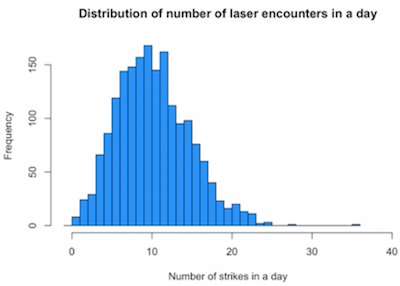
Analysis by day of the week, and by month of the year, showed Friday and Saturday evenings as having a greater likelihood of illuminations. July through November saw higher-than-normal numbers of incidents.
The AirSafe study also looked at six selected metropolitan areas. It compared the number of flights to the number of incidents. Phoenix, Los Angeles and San Francisco had higher-than-normal numbers of incidents; Chicago and New York were about average, and Atlanta was below average.
From AirSafe.com: summary page, and detailed analysis as a webpage, PDF and RPubs versions. Links are given to the raw FAA data, the processed version used by AirSafe, and statistical R code. Thanks to Dr. Todd Curtis who did the study and brought this to our attention.
US: UPDATED - "Star Shower" home laser projector raises aviation concerns
Between November 18 and December 6 2015, there have been at least three incidents, involving six aircraft, where pilots were illuminated with light from “Star Shower” laser projectors. In all cases, the illumination appeared to be inadvertent. The devices were being used for holiday decorating, and stray beams went into airspace. (E.g., a person was not knowingly aiming the Star Shower at an aircraft, or the flight path of an aircraft.)
The Star Shower emits “thousands” of laser beams from two sources, one green and one red. A homeowner can simply aim the Star Shower at her house or foliage, and instantly cover it with green, or green plus red, laser dots.
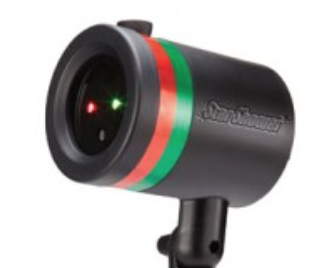
The projector head. It screws into a stake that is placed in the ground for outdoor use.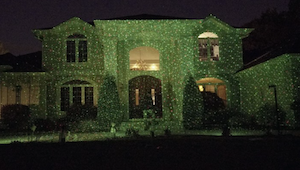
A home densely covered with laser “stars” from multiple Star Shower projectors. Both photos from the Star Shower website.
According to a comprehensive story in Inquisitr, Star Shower is so popular that it is sold out in many locations. TravelPulse calls it a “laser cannon.”
The Federal Aviation Administration on December 8 2015 tweeted “Decorating for the holidays? A stray laser could blind a pilot.” They then provided a link to general information about laser/aviation safety. An FAA spokesperson told CBS Philly, ““I don’t think anybody who buys these devices even think they have enough power to hit an aircraft in the sky…. If the box is aimed a little high, some of the lasers will not hit the roof of the house, they’ll keep going into space.”
While there is no warning on the outer packaging, the Star Shower instruction sheet says: “NOTICE: Lasers should not be projected at or within the flight path of an aircraft within 10 nautical miles [11.5 miles] of an airport. If your intended surface is within 10 nautical miles of an airport, lower the angle of the Star Shower so that no lasers point into the sky.”
In a December 9 2015 statement to NBC Los Angeles, the manufacturer added: “Star Shower Laser Lights operate by taking a single laser beam and diffracting it into thousands of individual laser beams. Each beam emitted by Star Shower is much lower in power than a typical laser pointer. Each individual laser beam is 10 times less than the maximum permissible exposure (MPE) allowed by the FAA normal flight zone (NFZ) criteria.”
In an urban or suburban environment, it is likely that most homes are within 10 NM of some type of airport. It may not be a major metropolitan airport; it could be a small general aviation facility. In a December 3 2015 incident, a Boeing 737 at 13,000 feet and 22 miles east of Dallas-Fort Worth Airport, reported seeing lights from what was believed to be a “laser holiday light display.”
From the FAA, Inquisitr, NBC Los Angeles
Analysis and commentary by LaserPointerSafety.com
ADVICE FOR OUTDOOR USE
After purchasing and testing a Star Shower, here is our summary advice for consumers. Details then follow.
The Star Shower is essentially eye-safe, and does not cause direct interference (glare) with pilots’ vision after about 411 feet. However, a single beamlet can be a distraction to pilots at least 3/4 of a mile away, and possibly further away due to the large number of laser dots aimed into the sky causing a flashing effect.
For this reason, a Star Shower needs to be aimed so that beams don’t go into airspace. You do not want an officer knocking on your door because a pilot saw and reported your home laser projector. While it is unlikely you would be arrested for an unknowing aircraft illumination, federal penalties for laser pointer misuse range up to five years in prison and up to a $250,000 fine.
Putting the projector closer to a house will keep more of the beams on the structure. Similarly, don’t aim it up into a tree unless the tree is very dense, such as an evergreen.
It should also be noted that there are reports such as this and this of Star Showers being stolen from yards. If you put your projector on a roof or up in a tree, aiming downwards, this both helps aviation (no beams going up into the air) and makes it harder to steal the projector. Finally, if you are in a heavy air traffic area, you might want to consider restricting it to indoor use only.
IS A STAR SHOWER LEGAL?
Under U.S. federal law, the Star Shower is legal to own and operate. As a Class IIIa (3R) laser, there are no federal restrictions on its use. The federal law prohibiting laser pointer misuse may not apply, for two reasons. 1) It prohibits knowingly aiming at an aircraft or its flight path, and 2) the law applies to “laser pointers…designed to be used by the operator as a pointer or highlighter….” This definition would not seem to apply to a device that is not a pointer, and is not used “…to indicate, mark, or identify a specific position, place, item, or object.”
A few states or localities may have restrictions on lasers that would affect Star Shower. Since it is not a laser pointer, and is not used for pointing, restrictions that cover laser pointers may not apply (depending on the exact definition). Some selected state and local laws are here.
Common sense says that a person should not stare into the beams, and that they should not be aimed to harass others. Similarly, the beams should not be aimed down a road or up into the sky, where they could interfere with drivers or pilots.
PURCHASING AND PACKAGING
In early December 2015, we purchased a Star Shower for $40 from a CVS drugstore. The box lists a sales website at BulbHead.com, and the distributor as Telebrands. It also says “Made in China.”
Both the box and the device have the proper FDA-mandated laser safety labeling. The device is FDA Class IIIa, meaning less than 5 milliwatts output. There are two apertures, one for 532 nm green laser beams and one for 650 nm red beams. A diffraction grating in front of each laser breaks the single beam into dozens or “thousands” of less-powerful beamlets. In a foggy or smoky environment, it is possible to see the beamlets in the air, but they are too weak to be seen in clear air.
Although the Star Shower has been popular for the Christmas 2015 season, the packaging does not emphasize this. Instead it says the Star Shower is “great for” indoor, landscaping, holiday, winter and summer uses. The advantages are: “No ladders, no hanging, no dead bulbs, no mess — just plug it in.”
TESTING
We took it to laser expert Greg Makhov of Lighting Systems Design Inc. for testing. Keep in mind that he tested just this one sample unit; we assume it is representative of the other Star Showers that have been sold.
Makhov used two different types of power meters, both which could measure in the microwatt and milliwatt region. He found that the maximum power of a single beam was 0.4 milliwatts. The chart below shows details.
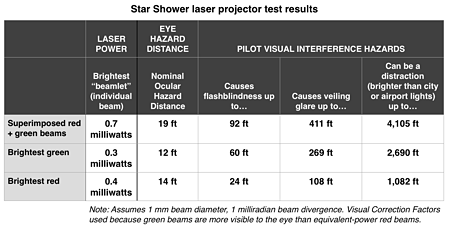
ESSENTIALLY NO EYE INJURY HAZARD
The brightest single beam, at 0.4 mW, is below the 1.0 mW Class II limit. Class II laser pointers are generally considered to be safe for accidental exposure. Eye injury from a Star Shower would be almost impossible unless a person at close range deliberately overcame his aversion to bright light and stared for many seconds into one of the beamlets, keeping it at the same spot in his visual field.
While the chart shows the Nominal Ocular Hazard Distance to be as far as 19 feet, keep in mind this is a “nominal” hazard. This does NOT mean that beams will cause injury at this distance. There is a kind of safety factor built in to the NOHD. A quick approximation is that at about 1/3 the NOHD (about 6 feet in this case), there is a 50-50 chance of a laser kept steady on the eye causing the smallest medically detectable lesion on the retina, under laboratory conditions.
GLARE UP TO 411 FEET, DISTRACTION TO 3/4 MILE
The chart also shows the visual interference hazard distances. For example, a pilot could experience veiling glare (she can’t see past the light) up to 411 feet away from the Star Shower projector. The light does not interfere with vision, but is a mental distraction, up to 4,105 feet away — a little over three quarters of a mile.
The above eye and visual interference calculations are for a single beamlet, for two reasons. First, at aviation distances, only one beamlet would enter the eye at a time. They are not so close together that two separate beamlets of the same color would be within one pupil diameter. The second reason is that even a person is so close to the Star Shower that two separate beamlets enter his pupil, each one will be focused onto a different area of the retina. This means that the beams don’t overlap — they are heating different areas. This is why we are primarily concerned — both for eye safety and for aviation interference — with the hazard of a single beamlet.
Now, when a helicopter flies through the dozens or “thousands” of laser beams, this can be more distracting than a single beam. It is no wonder that a pilot might report the laser display, and have it re-aimed or shut down.
Although an FAA spokesperson said a Star Shower was reported by a pilot who was at 15,000 feet, at this distance any single beamlet would be far below the FAA’s distraction limit. This means any beamlet would be no brighter than surrounding city or airport lights. It could be that the large number of beamlets caused flashes as the aircraft flew through them, and that this flashing was itself a distraction. Either way, no competent pilot at 15,000 feet should have any visual interference from a Star Shower. The only problem could be mental distraction, if the pilot paid more attention to the light than to flying the aircraft.
DISASSEMBLY AND HACKING (UPDATED DECEMBER 2016)
In early December 2016, Julius R. wrote to us wondering about the safety implications of opening the Star Shower and removing the star-creating holographic diffraction grating.
Our Star Shower, purchased in December 2015, has four security screws hidden behind rubber caps. The screws are at the bottom of a 2-1/4” deep shaft that is 5/16” in diameter. The screw head shape is a triangle with a raised dot in the center: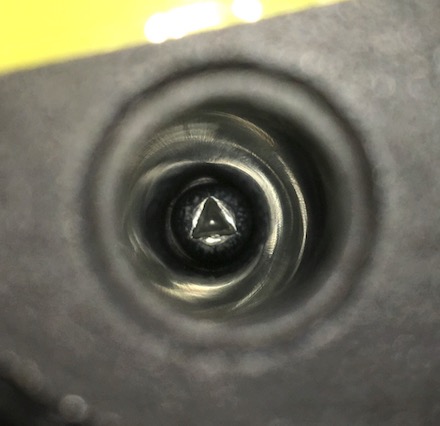
It would require a long screwdriver with a matching tip to reach and undo the screw. A brief search of Google Images to try to find such a screwdriver did not turn up any instances.
Certainly someone might be able to find such a tip, or to grind a shaft to fit. And breaking the Star Shower’s plastic housing could also give access to the inside. So if someone really wanted to get at the interior lasers, it would be possible.
We estimate that each of the lasers on the inside would be in the 10 to 50 milliwatt range. This power can cause an eye injury, although the injury would be relatively minor (assuming an unintentional exposure; deliberate staring into any laser beam should never be done). It is at the low end of Class 3B lasers.
There are similar lasers, and much more powerful ones, readily available online. They would be cost the same or even less, and would be much easier to use. So a laser hobbyist or hacker is unlikely to use a Star Shower as a source for red and green single-beam lasers.
In short, disassembly and misuse of the interior lasers is not a significant safety concern.
FOR FURTHER INFORMATION
Anyone with further questions can contact us; click the link below in the footer at the bottom of the page.
UK: Professor develops laser-absorbing strip for police face shields; "several thousand" used in Northern Ireland
The strip was developed by John Tyrer of Loughborough University, professor of optical instrumentation. He was commissioned by the Home Office and the PSNI who were concerned about increasing numbers of demonstrators aiming laser pens at police.
The light distracts officers and breaks their positions, according to Tyrer. The orange-tinted film is low-cost and simple to apply.
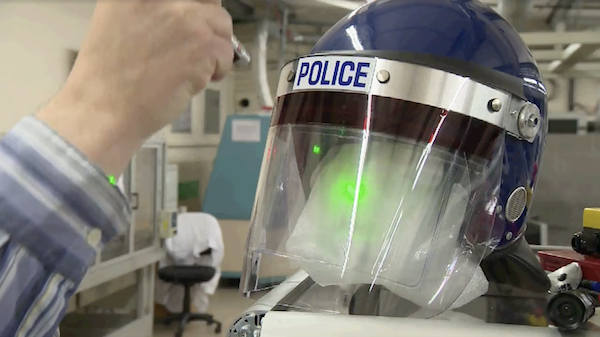
Tyrer demonstrates how light from a laser pen goes through the clear part of the face visor, causing glare and potential eye injury to an officer.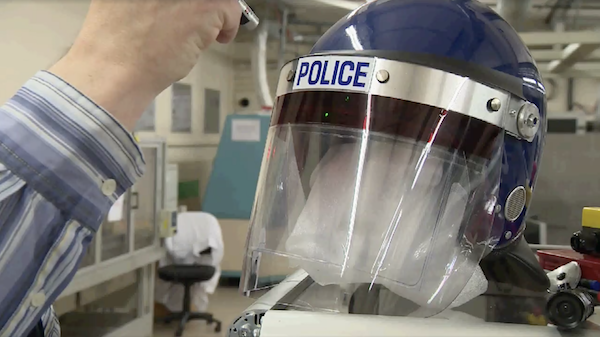
But if the officer tilts his or her head down so the laser goes through the strip, laser light is absorbed and does not present a hazard.
Testing by Public Health England, and real-life usage in Northern Ireland, showed the anti-laser strip to be “very effective”.
Tyrer has also suggested that the same film applied to glasses can protect pilots during takeoffs and landings from any laser activity that might be occurring.
From the Loughborough News Blog and Police Oracle
UPDATE JULY 27 2020: The visor strips are sold by Laser Optical Engineering Ltd. in the U.K. Pricing is £25 (USD $32) per strip in low quantities (<200). According to LOE, in field use it was found that direct attacks on police "stopped quickly" once protesters knew their lasers were ineffective and that laser attackers would be identified and arrested. LOE also sells anti-dazzle glasses. Pricing is £50 (USD $64) each in low quantities (<50).
Additional information about laser use and mis-use at protests, and ways to protect eyes is on the Laser use during protests page.
US: Sen. Schumer asks FDA to regulate sale of green lasers to public
The following is a press release issued by the Senator, followed by (after the “Read More:” link) a copy of the Senator’s letter to the FDA Commissioner:
Standing in the terminal at Buffalo Niagara International Airport in Cheektowaga, NY, U.S. Senator Charles E. Schumer today called on the Food and Drug Administration (FDA) to ban the sale of high-powered, long-range green laser pointers to the public. Schumer’s push comes on the heels of multiple incidents in which green lasers were pointed at aircraft and temporarily blinded and disoriented pilots mid-flight. This includes the recent incident two weeks ago when the pilot of a FedEx plane flying over Jamestown reported a green beam of light coming from a laser on the ground lighting up the aircraft. Schumer said that while it is lucky no one was harmed in the Jamestown incident or any other green laser attack, the federal government should act before a horrific event occurs, not after.
“Simply put: these green, long-range, high-powered laser pointers are a danger to our pilots and the hundreds of passengers whose lives depend on their eyesight and training. While we are very lucky the recent incident in Jamestown did not yield devastating results, we cannot sit idly by and wait for a horrific incident to occur before we act,” said Schumer. “That is why I am calling on the FDA to use its authority to regulate these dangerous devices. They're quickly becoming the weapon of choice for wrong-doers who want to harass our pilots and put passengers’ lives in jeopardy, and they should be banned before people are seriously hurt.”
Schumer said there has been a recent onslaught of green laser pointer attacks on aircraft that threaten the safety of pilots, passengers, and civilians on the ground. According to a USA Today report, the Federal Aviation Administration (FAA) recorded more than 5,300 laser strikes from January of this year through October 16, up from the more than 2,800 laser strikes reported in 2010. Schumer said numbers like these suggest a widespread misuse of the product and mean it should only be available to qualified professionals. According to the same USA Today report, between the night of November 11 and the morning of November 12, federal authorities reported 20 laser strikes on aircraft across the country, including the case in Jamestown. Schumer said the fact that the plane was flying more than 23,000 feet in the air shows how powerful these lasers are, and how dangerous they can be when they get into the wrong hands. As a result, Schumer is urging the FDA to ban the sale of high-powered, long-range green laser pointers to the public.
Laser pointers at one time were primarily used for presentation purposes in boardrooms and classrooms, they are now wildly available at trinket shops, flea markets, retailers and on the Internet, and are much more powerful. According to the FDA, laser pointers can be momentarily hazardous when staring directly at the beam. For pilots, these green lasers can cause flash blindness, a temporary or permanent loss of vision when the light-sensitive parts of the eye are exposed to an intensity of light they are not physically meant to handle. In addition, research suggests green lasers are more dangerous to the eye than red lasers because the light spectrum is more easily absorbed by the retina and more susceptible to damage. In fact, green lasers are considered to be more than double the strength of other colored lasers and can travel for miles, according to many media reports and health and aviation experts. Schumer there are certain types of lasers for which manufacturers must obtain FDA permission before they can be sold in the U.S., and green lasers should be included in that category so they are only sold to professionals, rather than would-be pranksters.
Because the FDA has the authority to regulate these lasers and their manufacturers, Schumer is strongly urging the federal agency to make high-powered, green laser pointers unavailable for public sale; they should be restricted to those with a specific professional purpose. Schumer said that while perpetrators convicted of pointing a laser at a plane can be sentenced to 20 years in prison and a $250,000 fine, they are often hard to track down following an incident. Because the products are merely required to have a warning label, Schumer said more must be done to limit public availability in order to protect public health and safety.
Schumer was joined by Adam Perry, Aviation Committee Chairman at the NFTA, Kimberly A. Minkel, NFTA Executive Director, and George Gast, NFTA Police Chief.
“I applaud Senator Schumer for his efforts to ensure the safety of our aviation industry,” said Kimberley A. Minkel, Executive Director of the Niagara Frontier Transportation Authority. “I hope the FDA responds to the senator’s request in a manner that will make it much more difficult for laser pointers to be available. Lasing is a serious crime that poses an imminent threat to aviation safety and could result in a pilot losing control of their aircraft, thus potentially causing mass casualties.”
Previously, the FDA has noted concern about the increased availability of some laser products. According to a March 2013 study by the National Institute of Standards and Technology (NIST), green lasers generate green light from infrared light, from which the eye cannot protect itself. In that NIST report, the agency noted that ideally, the device should be designed and manufactured to confine the infrared light within the laser housing. However, according to the NIST results, more than 75 percent of the devices tested emitted infrared light in excess of the Code of Federal Regulations (CFR) limit.
Schumer said in New York incidents of green lasers pointed at aircraft have been numerous and significant. In addition to the most recent one in Jamestown, there were 39 laser incidents between January 1, 2015 and May 15, 2015 in New York City alone. In 2014, there were 17 green laser incidents out of a total 19 laser incidents at JFK airport; 37 green laser incidents out of a total 41 laser incidents at LaGuardia Airport; 20 green laser incidents out of a total 28 at Newark.
There are four major hazard classes (I to IV) of lasers, including three subclasses (IIa, IIIa, IIIb). The higher the class, the more powerful the laser. Consumer laser products include classes I, II and IIIa and lasers for professional use may be in classes IIIb and IV. Laser pointers are included in Class IIIa. The FDA requires warning labels on most laser products, including the power output and the hazard class of the product. Some lasers are strictly for use by medical, industrial or entertainment professionals and can only be used by a person with a license and training.
A copy of Senator Schumer’s letter to the FDA appears below: [click on the “Read More…” link]
Click to read more...
UK: 400+ laser incidents in the first half of 2015
From January 1 to June 30 2015, there were more than 400 laser incidents reported to CAA. Heathrow had the most incidents by count, with 48 in the first half of the year. (This is actually fewer incidents per month than last year, when there were 168 total Heathrow laser reports for all of 2014.)
By proportion of laser incidents to air traffic volume, there was a higher frequency of attacks at regional airports such as Birmingham, East Midlands, Leeds Bradford and Newcastle.
The British Airline Pilots’ Association (BALPA) on November 2015 released the results of a survey of its pilot members, showing that 50% had reported a laser/aircraft incident during the period from November 2014 to November 2015.
From the Guardian and the Express. The CAA and BALPA statistics were released along with news of a British Airways pilot who reportedly suffered severe retinal injury from a spring 2015 exposure to a “military-strength” laser.
US: Slightly more than average number of laser incidents grabs media attention
Except for the involvement of multiple helicopters in New York City, the twenty November 11 overnight events were actually close to the current 2015 average of the 18.3 reported incidents per night.
It is normal for day-to-day incident numbers to fluctuate. For example, a day later on November 12, there were six incidents according to Slate.
Another example of the variability of daily incidents is shown by the day-to-day numbers for 2014. During the year there was an overall average of 10.7 incidents per day. The graph shows that daily numbers (light line) varied from 0 reported laser incidents to 24. (The dark line shows a 30-day moving average, to help smooth out the data. Day-to-day figures for 2015 are not yet available.)
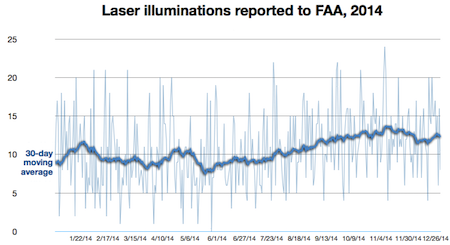
The U.S. Federal Aviation Administration made a Facebook post describing the November 11 incidents:
More than 20 aircraft were struck by lasers from the ground last night while flying over cities across the United States. Three laser strikes were reported in the New York City/Newark, N.J early in the evening, followed by three incidents in Texas, where jets were struck while preparing to land at Dallas Love Field. By late evening, pilots reported laser incidents in:
New York/Newark; Dallas; Jamestown, NY; Oakland, CA; Covington, KY; Danville, KY; Palm Springs, CA; Salt Lake City; Los Angeles; Albuquerque; Detroit; Ontario, CA; St. Petersburg, FL; Springfield, IL; San Juan, PR; Sacramento
None of the pilots reported injuries. Nevertheless, shining a laser at an aircraft is a federal crime that the U.S. vigorously pursues. Lasers distract pilots from their safety duties and can lead to temporary blindness during critical phases of flight, such as takeoff and landing. In some cases in the past, pilots have reported eye injuries that required medical treatment.
As of Oct. 16, the total number of laser strikes around the U.S. this year was 5,352.
Media stories that referenced the incidents included the following headlines and leads:
With new flurry overnight, laser strikes on aircraft hit record pace, USA Today
“Laser strikes on planes are growing even as the federal government enacts tougher penalties for people caught shining the devices. Overnight Thursday federal authorities fielded reports of more than 20 laser strikes on aircraft, adding to an already record-breaking number of strikes this year.”
Overnight outbreak of lasers pointed at aircraft, CBS Evening News
“The FAA says 20 aircraft were targeted by people with bright laser pointers Wednesday night in cities across the nation. Kris Van Cleave reports on the surge in these types of incidents.”
FAA: Lasers beams hit more than 20 aircraft overnight, Washington Post
“Federal authorities have launched an investigation after numerous aircraft were hit by laser beams Wednesday night. More than 20 aircraft were struck while in flight over at least 16 U.S. cities, according to a statement from the Federal Aviation Administration. Authorities said three strikes were reported to the FAA in the New York City area, followed by three in Texas that hit jets that were preparing to land.”
Lasers hit 20 aircraft flying in U.S. overnight - FAA, Reuters
“Dangerous beams from handheld lasers struck 20 aircraft flying over the United States and its territories overnight, among the nearly 5,400 laser hits in the nation so far this year, the Federal Aviation Administration said on Thursday. No injuries were reported in the incidents, which took place from New York City to Sacramento, and resulted in at least one arrest. Authorities said the incidents did not appear to be linked to each other.”
6 aircraft hit by lasers in New York, Dallas on Wednesday, Fox News
“Three news helicopters in New York and three planes near Dallas were hit by laser beams on Wednesday, according to the Federal Aviation Administration. Pilots for choppers flying for CBS New York, WNBC and WABC each described seeing a laser in their cockpit while flying over a scene in Park Slope, Brooklyn, CBS reported.”
High Number Of Laser Strikes In One Night Has Pilots Uneasy, CBS Sacramento
“The Federal Aviation Administration is looking into a series of laser strikes on aircraft across the country, including a possible strike at Sacramento International Airport. The exact details of that reported laser strike have not been made available yet, but for pilots these little beams of light are a huge concern. It was a busy night for law enforcement and air traffic control across the nation, with more than 20 pilots reporting laser pointers aimed at their cockpits.”
US: Doctors warn laser eye injuries may be misdiagnosed as genetic disorders
Such misdiagnosis has medical and financial consequences from the additional diagnostic workups and DNA sequencing used to detect hereditary genetic disorders such as rod monochromatism, Stargardt disease and occult macular dystrophy.
In addition, the paper describes five cases of where children using laser pointers experienced blurry vision and had eye injuries. “In some cases, the vision was as poor as 20/80, which is bad enough to fail a driving test,” said researcher Dr. Stephen Tsang, who is affiliated with Columbia University and NewYork-Presbyterian Hospital.
Dr. Tsang and his colleagues noted damage patterns similar to tree branches on the children’s retinas:

They suggest that eye-care professionals should ask patients with such patterns if they have been using lasers. Because children may be hesitant to talk in front of their parents, the researchers also suggest talking to a child alone.
A Columbia University press release noted “Since the publication about the five patients, the researchers have seen several more children with laser-induced eye injuries, suggesting that these cases are not isolated phenomena.”
From Columbia University Medical Center Newsroom, Nov. 5 2015. The Ophthalmic Genetics article “Laser induced photic injury phenocopies macular dystrophy” is not yet online as of this date, but can be found at the journal’s website.
US: From 6,500 to 7,100 laser incidents estimated for 2015
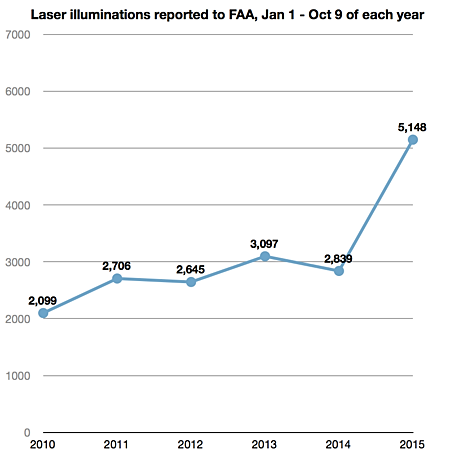
Based on trends in the years 2010 through 2014, this means that at the end of 2015 there could be between roughly 6,500 and 7,100 reported incidents. (The range is because in some years, the yearly total was between 1.28 and 1.37 times the Jan. 1 - Oct. 9 total.) We estimate that 2015 is likely to have roughly 6,850 incidents. This would be 176% of the 2014 total of 3,894 incidents.
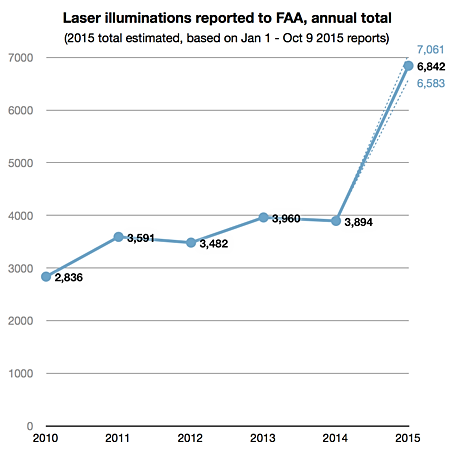
Stated on a daily basis, the number of reported incidents is expected to rise from 10.7 per day in 2014 to between 18.0 and 19.3 per day in 2015.
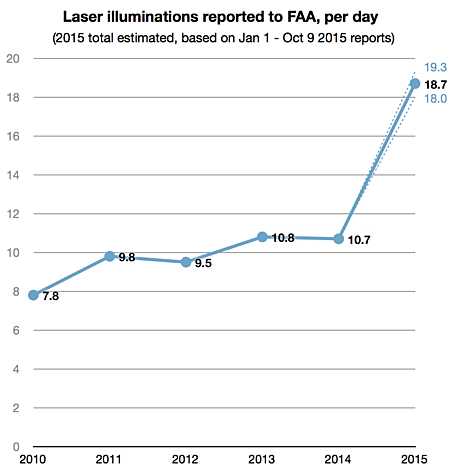
2015 information provided by FAA on November 5 2015. Statistical analysis done by LaserPointerSafety.com based on prior year FAA records.
US: College football team given 120 lasers to "make a point"
Herman was later quoted as saying “When you can see all these lasers everywhere, it just kind of represents everything that goes on in the lives of 18- to 22-year olds. We needed everybody to shut all that out and bring all that into one common focus.”
The tactic may have helped; the Houston Cougars went on to beat the Vanderbilt Commodores 34-0 on October 31 2015.
From the Houston Chronicle and Examiner.com
General: How many laser pointers to kill a human?
Author Adam Clark Estes begins with a primer on laser light, and determines that the beams from many lasers would have to be focused on a single spot. Estes quoted Dr. Rebecca Thompson of the American Physical Society:
“…if you wanted to create a death ray with laser pointers, you could buy 200,000 laser pointers [cat-toy type with 5 milliwatt output each], mount them on a piece of a sphere with radius 5.5’, aim them all through a lens and ask your victim to sit very, very still.”
The article concludes “Do not try this at home.”
From Gizmodo. Thanks to Roberta McHatton for bringing this to our attention.
US: Aviation reporter says FAA anti-laser efforts aren't working; wants more social media
Negroni began the segment by noting that laser incidents are “truly a menace and it’s not to be taken lightly.” She said offenders “don’t watch the news, they don’t read the paper” and thus “they need to be reached out on their level. And that level is like a Facebook level or a Twitter level, where people are actually going to learn.”
She concluded that “it’s just time for the establishment to get on board, before something really terrible happens.”
Negroni has written aviation articles for publications such as the New York Times and Smithsonian Air & Space, is an on-air expert for ABC, CNN and NBC, and has a book on mysterious aviation accidents coming out in 2016. She previously wrote an article for RGN critical of FAA laser publicity efforts entitled “No let-up in laser attacks on airplanes” published December 13 2013, and a blogpost on the same topic on August 28 2014.
From the Runway Girl Network podcast episode 27, “Crash Investigations and Laser Incriminations”, uploaded August 29 2015. A transcript of the laser-relevant parts of the podcast is below.
Click to read more...
US: Lasers create light fence to protect birds in Hawaii
According to the Kaua’i Island Utility Cooperative, “The lasers are similar to common laser pointers and use a narrowly focused green beam of light. Because the beams are parallel to the ground and because the installation is not in designated air space, the lasers do not pose a hazard to aircraft or passersby.”
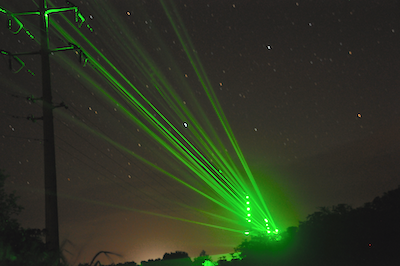
Lasers create a “light fence” to illuminate transmission poles and power lines in ‘Ele‘ele, Kaua‘i in August 2014. Kaua‘i Island Utility Cooperative is again experimenting with lasers and other devices to reduce collisions between endangered seabirds and utility equipment during the season when the seabird colonies are most active. Photo credit: Shelley Paik, Kaua‘i Island Utility Cooperative
From a press release by the Kaua’i Island Utility Cooperative (reprinted below).
US: Sullenberger says drones, laser pointers are dangerous; need certain prosecution
DICKERSON: So, the final question, Sully, I want to ask you about these reports about near misses from drones and commercial airlines. How dangerous is that?
SULLENBERGER: Well, because they are easy to get and they're relatively inexpensive, these devices are becoming ubiquitous. And that is true not just of drones, but of laser pointer attacks. And so it allows people to do stupid, reckless, dangerous things with abandon. I am heartened that the aviation and the legal authorities have raised the penalties for doing these things. Unfortunately, the essential element that is still missing is the certainty of prosecution, because it has been difficult to catch them in the act. This must stop.
DICKERSON: Very quickly, though, what could possibly happen, though, with one of these drones? I mean, how bad could it get?
SULLENBERGER: Well, we have seen what a six-pound or an eight-pound bird can do to bring down an airplane. Imagine what a device containing hard parts like batteries and motors can do that might weigh 25 or possibly up to 55 pounds to bring down an airplane -- it is not a matter of if it will happen. It is a matter of when it will happen.
Sullenberger successfully ditched U.S. Airways Flight 1549 in New York’s Hudson River in January 2009, after multiple bird strikes caused both engines to fail just after takeoff from LaGuardia Airport. Since 2011 he has been a CBS news aviation and safety expert commentator.
From the Face the Nation transcript and the Wikipedia page for Sullenberger
US: New pilot protective "anti-laser" glasses announced
The glasses block three laser wavelengths, in the red, green and blue regions. According to Dr. Perricone, “The real challenge was how do you block out red, blue, and green without changing the color discrimination. It’s critical a pilot sees color. He has to look at his instruments, he has to look at runway lights and a lot of other signals.”
A July 30 2015 news story said the glasses “have been manufactured and are ready for purchase, costing $400 a pair.”
Dr. Perricone was quoted as saying that if pilots are required to wear glasses like these, “then this problem will go away. No one is going to throw rocks at a window that won’t break.”
From WTNH.com
Canada: Saskatoon officials warn about laser pointer hazards
One pilot said that lasers have been pointed at him “at least 10 times in the past 3 years.”
A CJME news story notes that “pointing a laser at planes could land those responsible in hot water under the Canadian Aviation Regulation Act. Potential penalties range from fines of $3,000 to multi-year probation sentences and incarceration. Charges could also include mischief, assault with a weapon and assault of a police officer.”
From CJME.com and 620CKRM.com
US: Coast Guard says NJ laws have not reduced laser strikes
Delaware Online reported from the event that “[l]asers have been a point of contention in Ocean City [MD] for years, with the council deciding to ban the sale of them last summer, and make it illegal to possess a laser pointer in public. Similar laws have gone into effect in New Jersey, but the Coast Guard hasn’t seen a decrease in laser strikes, [Lt. Shawn] Glavan said.”
According to The Dispatch, “Coast Guard Station Atlantic City, where [Glavan’s] MH-65 Dolphin [helicopter] is based, handles around two or three incidents a week involving individuals shining lasers on the aircraft. Coast Guard Air Station Atlantic City’s response area covers a large swath of the mid-Atlantic including Ocean City and as far south as Chincoteague.”
From DelawareOnline, CBS Baltimore and The Dispatch
Saudi Arabia: Handheld blue-light lasers can cause macular hole in retina
The study, reported in the July 2015 American Journal of Ophthalmology, looked at 17 eyes of 17 patients at two institutions, between January 2012 and May 2014. Most were youths (mean patient age 18 years; range: 11 to 30 years old). The eyes were exposed to blue laser light for less than one second, at a mean distance estimated to be about 1 meter from the laser. The time from exposure to the patient visiting the hospital for treatment ranged from two days, to almost 500 days.
Patients were given a full ophthalmic examination, including fundus photography, macular spectral-domain optical coherence tomography, and fundus fluorescein angiography.
The macular holes ranged from 0.17 millimeters to 0.62 mm, with a mean diameter of 0.35 mm.
In 14 of the eyes, surgeons went deep into the eye and removed vitreous gel (a pars plana vitrectomy); this removes clouded gel that may contain blood from the injury. At the same time surgeons also did a procedure called “internal limiting membrane peeling,” which uses an instrument to make a break in the membrane which is then peeled away with forceps.
In 11 of the 14 eyes, the operation completely closed the macular hole. Of the other three unoperated eyes, the eye with the smallest macular hole spontaneously closed.
Before the operation, the mean Snellen best corrected visual acuity (BCVA) was 20/210, or about 1/10th the normal visual acuity; the range was from 20/30 to 2/200. After the operations, the mean BCVA was 20/62 (range: 20/20 to 4/200). These statistics included all eyes (the 14 operated eyes and the three unoperated ones).
The authors concluded “Full-thickness MH can result from momentary exposure to high-power handheld laser devices. While spontaneous closure may occur in rare cases, most cases require early surgical intervention. Vitrectomy may be successful in closing the macular hole with visual acuity improvement in most of the cases.”
From the abstract of the study by Alsulaiman SM, et al., “Full-Thickness Macular Hole Secondary to High-Power Handheld Blue Laser: Natural History and Management Outcomes” in the American Journal of Ophthalmology, July 2015 Vol. 160, Issue 1, Pages 107-113.e1.
Note: Other studies have been published based on this data, an August 2013 LaserPointerSafety.com story about the first study is here.
US: FAA-reported laser incidents up significantly in 1st half of 2015
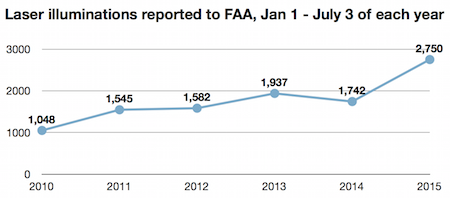
Based on past years’ trends, this means that at the end of 2015, there could be between about 5,600 and 7,400 incidents. (The range is because in some years, the second half of the year had 2.04 to 2.71 times the number of incidents in the first half.) We estimate 2015 is most likely to have about 6,300 incidents. This would be a 62% increase over the 2014 total of 3,894 incidents. 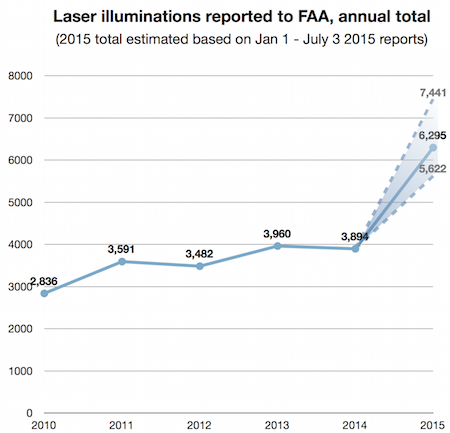
Stated on a daily basis, the number of incidents is expected to rise from 10.7 per day in 2014 to somewhere between about 15 and 20 incidents per day in 2015: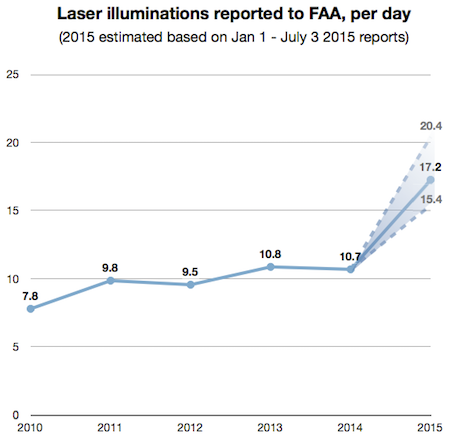
2015 information provided by FAA on July 10 2015. Statistical analysis done by LaserPointerSafety.com based on prior year FAA records.
Canada: Government launches safety campaign to warn against pointing lasers at aircraft
Helping Canadians better understand the dangers lasers pose to aircraft
The Honourable Alice Wong, Minister of State (Seniors), on behalf of the Honourable Lisa Raitt, Minister of Transport, today launched the Government of Canada’s safety awareness campaign for lasers. The national campaign will help Canadians better understand why pointing a laser at aircraft is not a bright idea.
The first phase of the campaign, unveiled today in collaboration with the Vancouver International Airport, the RCMP, and NAV CANADA, provides the public with an easy to follow infographic, which clarifies the dangers and consequences of pointing lasers into airspace and how incidents can be reported. This summer, the second phase of the campaign will include digital advertising, awareness videos and a direct mail campaign near three major airports.
Transport Canada has also launched tc.gc.ca/NotABrightIdea, which provides Canadians with the information they need to better understand the dangers of pointing a laser at an aircraft.
Transport Canada is working closely with police, other government departments, and the aviation industry to protect pilots, passengers, and people on the ground. If you see a laser pointed at an aircraft, report it to your local police.
Quick Facts
- The number of lasers pointed at aircraft is rising in Canada. In 2014, there were 502 reported incidents – a 43% increase since 2012.
- Aiming a laser at an aircraft is a federal offence. If convicted under the Aeronautics Act, an offender could face up to $100,000 in fines, 5 years in prison, or both.
- Canadians can join the conversation and learn more by using the #NotABrightIdea hashtag on Twitter.
US: Hobbyist builds 40 watt laser "shotgun"
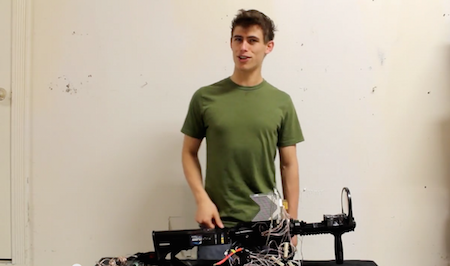
The hobbyist, with the username “styropyro,” wrote on YouTube: “Just finished building my 40W(!!!) laser shotgun!!! The output of this laser is complete insanity, and is made up of 8 parallel 5W laser beams totaling to 40W. The parallel beams are manipulated with lenses, sort of like how a choke modifies the spread of a shotgun blast. The massive diode array is powered by a huge lithium polymer battery pack (capable up dumping 250A) and the laser array is regulated by a whopping 24 LM317 drivers. This is definitely the craziest thing I have ever built, but I hope to beat this invention with something even crazier before too long.”
In the video narration, he said “I just built something so crazy that I’m almost afraid to use it” and “There is no, no good reason for anybody to own something this powerful. But because it wasn’t illegal for me to build, I decided to build it anyway.” The video then goes on to show the beam popping balloons, and burning paper, a ping-pong ball, and other materials.
Styropyro had previously posted other videos with titles such as “Homemade Lightsaber!?! MASSIVE 3W Handheld Laser Torching Stuff!!”, “My Homemade 6W Laser Sword!!!” and “Homemade Death Ray Laser DRONE BOT!!! Remote Controlled!!!”
From Gizmodo. Thanks to Patrick Daniel Murphy for bringing this to our attention via Reddit.
Japan: "Smartglasses" aim laser light directly into eyes
The laser is full color (red, green and blue combined) and is said to be harmless. The system was developed primarily as a vision aid for persons with visual defects. According to the news story, the image does not require focusing and is projected through the eye’s lens directly onto the retina.
The story notes that “the basic idea of projecting imagery onto a retina via laser has been around for decades, but miniaturizing the optics to realize a wearable form factor had been difficult until recently.”
A Fujitsu spinoff called QD Laser helped develop the glasses. They expect to begin selling them in March 2016 in Japan, Europe and the U.S. for about USD $2,000.
From PC World
US: Study shows windscreen coatings can reduce laser intensity
More information at the LaserPointerSafety.com page on the 2015 Nanocomposite coating study
Italy: Sharp rise in laser incidents to 1,189 in 2014
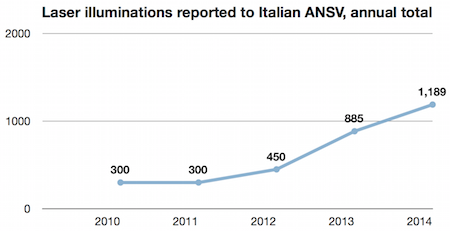
80% of the cases involved aircraft on approach, 15% involved aircraft taking off, and 5% happened during cruise.
The commander of the border police said he has never been able to identify the laser perpetrators. The fact that incidents occur in the dark, “coupled with the fact that a laser pointer can be easily hidden, makes it impossible to identify those responsible, unlike those who throw stones from the flyover. We think they are guys who do not realize the severity of what they do."
From Corriere Della Sera. Thanks to Alberto Kellner Ongaro for bringing this to our attention.
South Africa: Students warned not to bring lasers to school
It was unclear from news reports whether the warning was sent directly to students at school, or if the warning came only as part of a May 4 2015 news story on the website Health24.com. A May 11 search of the Gauteng Department of Education website did not show any announcements, notices, documents, or other information warning about laser pointer hazards.
The spokesperson said that at least two children had permanent eye damage from lasers. One case cited was a South African 11-year-old boy who looked into the laser light after one of his classmates was playing with it. His mother said “He now has a blind spot right in front of him, but still see the sides of the eye [sic].” This case was reported in April 2015. The other South African case involved a child who aimed a laser’s light into his eye and had permanent damage.
Gautang is the most populous province in South Africa. It contains the cities of Johannesburg, Pretoria, Midrand and Vanderbijlpark.
From Health24.com: Story about the warning to learners, and story about the 11-year-old boy being injured.
US: Survey paper says "Injury from laser pointer trauma is a public health problem on the rise"
It begins by summarizing misuse in sports, and in the thousands of incidents per year in the U.S. where lasers are aimed at aircraft.
The authors, Dr. Gregory D. Lee and Dr. David R. Lally, then write “Perhaps the greatest concerns are raised by reports of unsupervised children who have received these lasers as toys or gifts and expose themselves to the laser beams, causing permanent retinal injury with reduced central vision. From 2000 to 2009, there were five reports of 18 patients with injuries due to laser pointer exposure.”
They discuss the types of injuries (thermal, photochemical and mechanical) and locations of retinal injuries. There is a listing of laser classes, with “pointers” — Class 1, 2 or 3R (IIIa) — being distinguished from similar-looking but more powerful Class 3B and 4 “handheld” lasers.
The authors conclude as follows:
“Inappropriately used class 3B or 4 lasers should be considered weapons that can cause serious, permanent bodily injury. Even brief exposures to diffused rays of laser beams can cause temporary flash blindness that may last for hours in airline pilots, endangering the lives of passengers, particularly during takeoff and landing sequences. Cases of short-range laser exposure are becoming more common, often involving children who are inappropriately given these devices as toys, and these patients are referred to retina specialists after the damage has already occurred.
“No definitive experimental study, case report, or animal model has shown improvement in these injuries with any type of treatment, but typically these patients are treated with a short course of corticosteroids or nonsteroidal antiinflammatory drugs. Secondary choroidal neovascularization has been treated successfully with intravitreal anti-VEGF agents.13,14
“Clinicians, particularly retina specialists, can raise awareness of this rising public health issue by educating patients and parents about the hazards of laser pointers. Legislation is currently being written to impose stronger regulations on the distribution and sale of these devices. If a patient presents with findings of a laser-related retinal injury, clinicians should report the incident to the FDA so that investigations can be performed into the manufacturers of these devices. Reports can be made at www.fda.gov/downloads/AboutFDA/ReportsManualsForms/Forms/UCM236066.pdf.”
From Retina Today
US: Wall Street Journal examines link between males, laser offenders
It began by noting that in 89 of the 93 reported arrests last year for laser strikes against aircraft, the offender was male. The article quoted a New York laser safety officer, John Zelenka, as saying he has never seen a female playing with lasers.
A developmental psychologist was quoted as saying that lasers appeal to a masculine perspective. Patrick Murphy (editor of LaserPointerSafety.com) told the Journal “For a lot of guys it’s like, ‘The bigger the laser, the more visible, the more of a man I am.’”
Author Sophia Hollander then noted that the prices of a 20 mW laser dropped from $239 in 2004 to $8 in 2015.
She examined the similarity of “Star Wars” lightsabers and lasers, quoting experts on the appeal to males of a weapon that can “throw your influence.”
The online article was illustrated with photos from a lightsaber combat class held by the group New York Jedi. Actual lasers were not used in the class due to the potential hazards.
From the Wall Street Journal (article is behind a paywall)
US: Burning Man desert event bans handheld lasers after 2014 accident
In addition, volunteer Kelli Halston Hoversten suffered two permanent eye injuries during the climactic “Man Burn” in 2014. Her left eye was permanently blinded by a handheld laser, and her right eye was partially blinded by a vehicle-mounted laser. (The injuries significantly affected her. Hoversten “lost her job as an arborist because they can’t insure her now” and she no longer rock climbs or ice climbs recreationally due to the loss of depth perception. She is allowed to drive but “just barely” since her central vision is blocked.)
According to an article about the policy change in the Reno Gazette-Journal, Hoversten will attend the 2015 Burning Man event, in part because of the new laser policy.
The Burning Man ban on handheld lasers applies even to low-powered laser pointers less than 5 mW in power. In a separate blog post comment, Burning Man press official Will Chase wrote: “Because of the difficulty in discerning the difference between dangerous and non-dangerous handheld lasers — and because you don’t want to be wrong — it’s been decided to prohibit all handheld lasers.”
The new webpage with the laser policy also noted that the restriction on handheld lasers “is in line with nearly all major festivals and events in the United States and Europe.”
Non-handheld lasers are still allowed at Burning Man if they are on art installations, “DMV Mutant Vehicles,” or are in theme camps. Such lasers must be disclosed on the art, vehicle or camp application. An Event Safety Officer will review the applications; only safe uses will be allowed.
Click to read more...
US: "SteadyLaser" pointer said to reduce hand motion
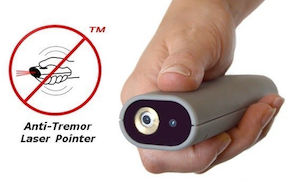
The SteadyLaser
The first version being sold on Kickstarter contains two Class 2 (<1 milliwatt) 635 nanometer red laser modules. The module on the left (in the photo above) is suspended inside the TV-remote sized SteadyLaser. It provides the stabilized beam. The other laser is non-stabilized, like a standard laser pointer. In the final Kickstarter version, the user can choose either either the stabilized beam or the normal beam, but — for safety reasons — not both at once.
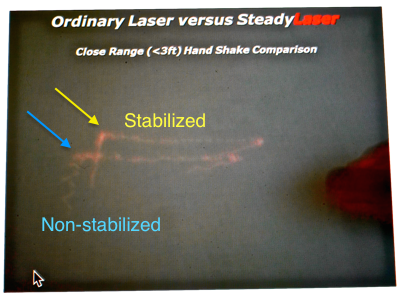
This is a 2-second exposure, from a Kickstarter video, showing both beams being emitted simultaneously in order to demonstrate the stabilization’s effect. The line traced by the stabilized laser is up and to the right of the non-stabilized laser’s line.
Pricing for the initial run of 1000 SteadyLasers is approximately $150 each. It is promoted on Kickstarter solely for presentations in professional locations such as businesses, schools and courts. The primary benefits are claimed to be minimizing distraction, and reducing the appearance of nervousness when using a laser pointer in presentations.
The Kickstarter page first went up approximately April 10 2015. As of April 13 there were 6 backers pledging $960. The goal is to get $150,000 in backing by June 9 2015; otherwise the laser will not become a product — or at least, not through Kickstarter.
Regardless of the Kickstarter outcome, the inventors want to license their patents to current laser pointer manufacturersd.
From SteadyLaser.com, the SteadyLaser Kickstarter page, and Sys-Con Media via PRNewswire
Commentary from LaserPointerSafety.com
There could be concern over a handheld laser that can remain steady on a target. If aimed at an aircraft’s cockpit, the beam would be able to stay in a pilot’s vision longer than a standard, non-stabilized laser pointer.
Because of this potential hazard, LaserPointerSafety.com contacted co-inventor Jeff Wilson, who kindly agreed to add an aviation safety warning to the SteadyLaser’s labeling, with text such as “Do not aim at vehicles or aircraft. This is hazardous and illegal.”
The first-generation SteadyLaser has low power (1 mW) and low apparent brightness (635 nm red, which appears only 25% as bright to the human eye as the common 532 nm green laser). Assuming a 1 milliradian divergence, the SteadyLaser is an eye hazard to 23 feet, can cause flashblindness up to 55 feet from the laser, can cause glare up to 245 feet, and would be a distraction to pilots (brighter than other city and airport lights) up to a half mile from the laser.
However, if future versions had more power — up to the U.S. FDA’s limit of 5 mW for laser pointers — and used a 532 nm green laser, then the hazard distances would increase as follows: eye hazard to 52 feet, flashblindness to 245 feet, glare hazard to 1,097 feet, and distraction hazard to 2.2 miles.
US: FAA says no known permanent eye injuries from laser pointers as of March 2015
Commentary from LaserPointerSafety.com: There have been many pilot claims of eye injuries caused by laser pointers aimed at their aircraft. FAA has investigated some of the most serious claims. In 2011, a person knowledgeable about these studies told LaserPointerSafety (on background): “I haven't seen anything that convinces me that any of the FAA incidents are true injury. I haven't seen any convincing evidence of delayed laser lesion effects. I do know that headaches and eye pain and photophobia and light sensitivity have been reported and associated with laser illumination. I have seen nothing convincing me that there is real cellular, tissue injury.”
There have been a few cases (<10?) of temporary eye injury, where the eye healed. This is similar to how skin can heal after a sunburn. In all of these cases, the pilots returned to flying.
There have also been cases of reported laser injury to the cornea. This is the transparent surface of the eye. Visible laser light passes right through and is not absorbed. The cause of these reported “laser” injuries is the pilot rubbing his or her eyes too vigorously, causing painful scratches in the sensitive cornea. Any damage from a visible laser beam would be on the light-absorbing retina.
Note that FAA limited its statement to commercial pilots. There may be military pilots in conflict zones who have been injured by laser weapons. If so, this information would be classified. Due to the seeming lack of urgency with FAA and U.S. military, any such injuries would not seem to be a threat to commercial pilots in the U.S.
Here are lists of all LaserPointerSafety.com news items tagged with the keyword “eye effect or injury”: aviation injury incidents, non-aviation injury incidents, other eye injury stories.
LaserPointerSafety welcomes any documented cases of pilot eye injuries. Contact us with the links etc., and also contact FAA so they can be aware of the cases.
US: NY senator wants FDA to ban green laser pointers
Schumer made the announcement at a Sunday press conference in his Manhattan office, along with four commercial airline pilots who had been illuminated by laser light. One pilot, Gabe Rubin, said he knew of a pilot who “suffered severe eye damage from a green laser pointer [and] will never fly again.”
Schumer said “Green lasers are the weapons of choice being used for evil purposes. We know terrorists are always looking for areas of weak points.”
He is focused on green pointers because they are apparently preferred by pranksters because the green light travels farther, and “because the light spectrum of green is more easily absorbed by the retina and then causes more damage”, according to the senator.
In 2012, Schumer wrote a letter to the U.S. FDA saying that laser pointers’ power should be less than the current 5 mW limit, that FDA should restrict more powerful Class 3B (5-500 mW) and Class 4 (500+ mW) lasers, and that FDA should require warning labels about aiming at aircraft.
From Newsday and CBS New York. The text of Sen. Schumer’s press release is below (click the “Read more…” link).
Click to read more...
US: Football coach, kicker propose laser goalposts for improved officiating

Goal post at Georgia Tech stadium. Photo by Hector Alejandro from Flickr CC by 2.0. Background darkened to emphasize the subject.
In a February 2015 interview with Sports Illustrated, Florida State University kicker Roberto Aguayo discussed the idea, first brought up by FSU head coach Jimbo Fisher (70 wins, 14 losses, 6 bowl appearances).
SI interviewer Martin Rickman asked “Jimbo mentioned his ideas about putting laser beams on top of field goal posts a while ago, and Georgia kicker Marshall Morgan brought up the notion again last season. Do you feel like electronic accuracy monitoring is something that should be implemented in kicking?”
Aguayo replied:
“Personally, I think the laser idea is a good idea. I’m still behind Jimbo. I’ll back him up on that. Games can be won or lost on a kick. I’ve seen it, a kick has gone close and one ref looks at the other. Not a lot of people know this, but my redshirt year, Dustin [Hopkins] was still kicking, and he hit a 27-yarder. He comes off the field and says, ‘Guys, I missed that.’ But the refs counted it in. They said it was good. It went right over the upright.”
“One of the kicks I missed this year went over the uprights, too. It looked like I missed it, but when they showed it on the JumboTron [TV scoreboard] the whole stadium booed. It looked good on the JumboTron. Depending on what angle you’re looking at, it’s hard. Lasers I feel like would be a good idea. It’s just about figuring out whether if it goes inside the laser it’s good, or if it touches the laser it’s no good. That would have to be discussed. Either get lasers or make the uprights a little bit longer. Kickers are getting much better and they’re hitting it a lot higher.”
From Sports Illustrated
UK: 1,442 laser incidents in 2014; up 3.4% over 2013
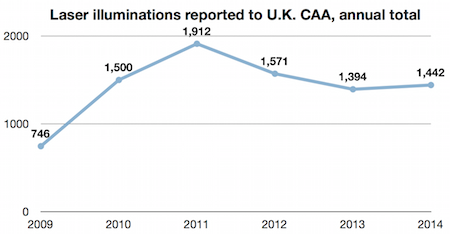
Additionally, there were 312 laser incidents that occurred outside the U.K. to U.K. operators.
In 2014, the top four most frequent incident locations were London/Heathrow (168), Manchester International (107), Birmingham (92), and Leeds Bradford (81). London/Gatwick and Glasgow were tied for fifth place, each with 64 reported incidents.
CAA published a PDF report with more detailed figures, including a monthly breakdown of the most frequent laser incident locations in 2014, and monthly & yearly totals for 2009 through 2014, and overseas (non-U.K.) incidents occurring to U.K. operators.
From the CAA PDF report dated February 2 2015. Note: There is a discrepancy where one table lists a total of 1,440 incidents in 2014 while another lists a total of 1,442. We have used the larger figure in this story.
Additional charts are on the page listing 2014 incident statistics, and the page with 2004-2014 historical data.
Canada: 502 laser/aircraft incidents in 2014
From the Transport Canada webpage Aiming a laser at an aircraft? Not a Bright Idea.
US: FAA releases spreadsheet with details of laser incidents, 2010-2014
This information was previously restricted and hard-to-obtain by the general public. The 3.6 MB Excel-format spreadsheet lists the date, time, aircraft ID, aircraft type, altitude, nearest major city, beam color, and whether an injury was reported.
The image below shows four days worth of data, January 1 through 4, 2014. Each row is one laser/aircraft incident.
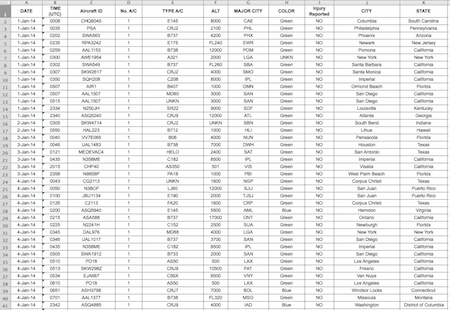
The spreadsheet, “Reported Laser Incidents for 2010-2014”, can be downloaded from FAA’s webpage Laser News, Laws, & Civil Penalties.
US: 3,894 FAA-reported laser illuminations in 2014; only 2.4% decline from 2013
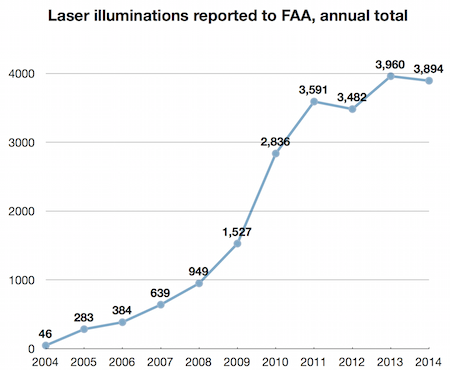
The chart below shows the number of incidents each day (light blue line) and a 30-day moving average (dark blue) to smooth out the data. In the first half of the year (Jan 1 - Jun 30) there were 9.4 incidents per day, but these rose in the second half to 11.9 incidents per day, making the 2014 final average of 10.7 incidents per day.
It is unclear why 2014 saw roughly level incident rates up to about June but then a steady increase over the next 5 months. One significant 2014 event was the February push by the FBI to publicize and prosecute laser pointer incidents, including offering a $10,000 reward. This was followed by another FBI push in June — after which rates started to rise.
The chart below shows 2014 in context with the past seven years. While the incident rates have leveled off to about 10-11 per day since 2011, all the publicity and prosecutions over the past few years have not brought the rate downward.
Finally, this chart superimposes each year’s laser illumination incidents, from 2009 through 2014. This gives an idea of the “shape” of each year. The heavy black line is 2014 data.
From public FAA Excel spreadsheet “Reported Laser Incidents for 2010-2014” at this page. For 2013 and previous years’ data, see the page FAA laser/aircraft incidents: 2004-2013 historical data.
